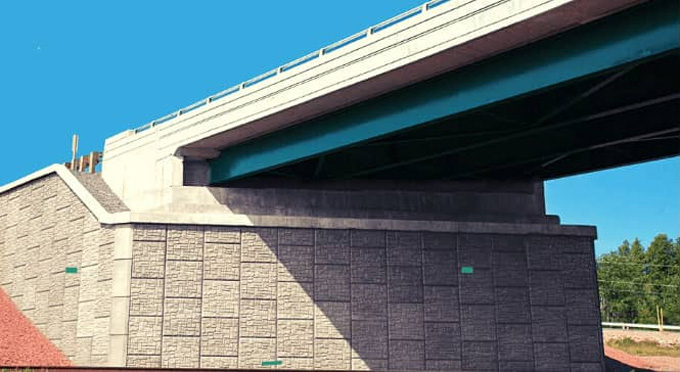
Design of Highway Bridge Abutments and Foundations

A bridge spans over a gap, for example, a river, road, or valley, which needs to be supported on both sides. These types of support structures for the bridge are known as the bridge abutment. The bridge abutment helps to carry the overall weight of the bridge, including the weight of pedestrians and vehicles, thus providing support to the bridge structure.

In addition, the bridge abutment also acts as a wall, which helps to retain the embankment of the road. The bridge abutment helps to connect the foundation structure at the bottom of the bridge and the bridge superstructure, thus transferring the overall weight of the bridge to the ground or rock below the bridge structure.
Discuss the different components of the bridge abutment
The bridge abutment has been built with different parts, which are as follows:
Bridge seat
The bridge seat refers to the horizontal shelf that is near or on the bridge abutment and used to support the bridge’s deck. The bridge seat has been used to secure the bridge’s end on the embankment. In addition, the bridge seat also provides support to relieve the long-term stress within the bridge structure.
Wing wall
The wing wall of the bridge abutment has been used for maintaining the slide slope embankment of the bridge structure. The wing wall uses short retaining walls, which help to protect the barrier from erosion.
Back wall
The back wall has been constructed vertically at the edge of the bridge and provides support for the extension joints of the bridge deck.
Footing
The footing of the bridge abutment has been buried into the ground, which helps to distribute the weight of the entire bridge structure. The footing of the bridge abutment also helps to connect the vertical portion and the load-bearing portion of the bridge abutment with the ground.
Abutment pile
The abutment pile is the filament which has been connected to the foundation of the bridge abutment and helps to support the seat of the bridge structure. The length of the abutment pile of the bridge abutment has been estimated on the basis of the depth of the obstruction, for example, river, canal or stream and the height of the entire bridge structure.
Discuss the different types of bridge abutments used in construction work
Gravity Abutment
These types of bridge abutments have the abiltyt ot resist water pressure and earth pressure. The gravitational force of the Earth helps to keep this bridge abutment on the ground because of its weight.
U-shaped Gravity Abutment
The wing wall of these types of bridge abutments is perpendicular to the seat of the bridge at a 90-degree angle, which is extremely durable. Reinforced concrete cement has been used to build the U-shaped gravity bridge abutment.
Stub Abutment
These types of bridge abutments only hold the slightly thick soil rather than the thickness of the bridge superstructure.
Semi-Stub Abutment
These types of bridge abutments are halfway between the stub abutment heights and full heights.
Cantilever Wall Abutment
The cantilever wall abutments help to resist the loads on the bridge structure and also provide pedestrian and automotive access to the bridge structure.
Full Height Abutment
These types of bridge abutments are appropriate for the congested and metropolitan regions, where the structural depth is needed.
Counter-fort Abutment
These types of bridge abutments have acted as the retaining wall for the counterfort.
Mechanically Stabilised Abutment
These types of bridge abutments are less expensive as compared to the other types of bridge abutments used in bridge structures.
Spill-Through Abutment
The spill-through abutments are prone to erosion, so it’s construction process should be done before the construction of the building structures.
Key functions of the bridge abutments
➢ he bridge abutment helps to transfer the wind load and bridge load from its dead weight to the soil.
➢ The bridge abutment also helps to transfer the weight of the bridge superstructure to the foundation components of the bridge.
➢ The bridge abutment also helps to ensure the safe landing of the bridge structure by supporting one edge of the approach slab.
➢ In the case of the arch bridge structures, the bridge abutment provides stability among the horizontal and vertical force elements.
Factors need to be considered while designing the bridge abutment
➢ The surface layout of the road subsurface of the bridge needs to be enlarged to avoid the dug area for the construction of the bridge abutment.
➢ It needs to be ensured that the length of the approach slab is appropriate for the width of the bridge deck and the height of the bridge abutment.
➢ The shear force failure should be avoided in the approach slab that owning to the poor soil.
➢ There should be a restriction on the differential settlement of the approach slab and bridge deck, as it leads to trip hazards.
To learn more, watch the following video tutorial.
Video Source: All About Bridge Engineering
Learn about the bridge abutment design process
While making the structural design of the bridge abutment, it is necessary to ensure that there is a proper thickness of the base and wall, as well as an appropriate size and spacing of reinforcements also need to be selected to prevent the risks of serviceability limit state failure.
Base design of the bridge abutment
The design of the base slab toe has been done to resist the highest ground forces acting on the base. The heel of the base slab has been built to resist the upward ground pressure. The foundation slab of the bridge abutment has been supported by the piles.
Wall design of the bridge abutment
The wall of the bridge abutment has been designed to resist the shear forces and bending moments. While designing the wall of the bridge abutment, the bending moments in the wall need to be calculated to accurately distribute the loads vertically.


